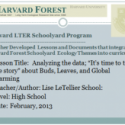
Keywords:
Climate Change Data Analysis Deciduous Trees Growing Season Phenology Scientific Method Trees Urban Ecology
Climate Change Data Analysis Deciduous Trees Growing Season Phenology Scientific Method Trees Urban Ecology
Description
Students explore how the timing of color change and leaf drop of deciduous trees in New England is changing. Students learn to collect data on important long-term ecological issues and processes. Student data is shared on the Harvard Forest LTER website. Students can access their data to graph and analyze, as well as access other school’s data.
Students explore how the timing of color change and leaf drop of deciduous trees in New England is changing. Students learn to collect data on important long-term ecological issues and processes. Student data is shared on the Harvard Forest LTER website. Students can access their data to graph and analyze, as well as access other school’s data.
Time Required
2 45 minute class periods
2 45 minute class periods
Teaching Tips
This lesson can be used by anyone interested in using a large database of Schoolyard data to help explore how the timing of color change and leaf drop of deciduous trees in New England is changing. When asked to make a prediction/hypothesis as to which species loses its leaves earliest in the fall it is not clear if students have observed trees in nature or have enough background knowledge to make a hypothesis. The Harvard Forest LTER also has a wonderful manual to assist teachers interested in integrating data into their curriculums that might be helpful. It can be found http://harvardforest.fas.harvard.edu/sites/harvardforest.fas.harvard.edu/files/data/k12/Colburn%202009%20Graphing%20Manual.pdf This investigation is not an experiment so a prediction or a statement such as, "Which tree loses its leaves earliest in the fall" would be better.
This lesson can be used by anyone interested in using a large database of Schoolyard data to help explore how the timing of color change and leaf drop of deciduous trees in New England is changing. When asked to make a prediction/hypothesis as to which species loses its leaves earliest in the fall it is not clear if students have observed trees in nature or have enough background knowledge to make a hypothesis. The Harvard Forest LTER also has a wonderful manual to assist teachers interested in integrating data into their curriculums that might be helpful. It can be found http://harvardforest.fas.harvard.edu/sites/harvardforest.fas.harvard.edu/files/data/k12/Colburn%202009%20Graphing%20Manual.pdf This investigation is not an experiment so a prediction or a statement such as, "Which tree loses its leaves earliest in the fall" would be better.
About The Science
Very thorough science activity has students access and analyze selected phenology data from the Harvard Forest Schoolyard LTER to study changes in the growing season of deciduous trees in New England. Students use the Harvard Forest database to access data on color change and leaf drop of deciduous trees. Database generates the graphs automatically. Students then compare their two years of data with a 21-year long term dataset generated by LTER Harvard Forest researcher. Students can be encouraged to generate their own graphs using Excel in the extension activities. Instructor should be aware that a two-year length of the graphing component isn't really long enough to discern trends. The sample conclusion statement did mention collecting more data over more years which would provide more information.
Very thorough science activity has students access and analyze selected phenology data from the Harvard Forest Schoolyard LTER to study changes in the growing season of deciduous trees in New England. Students use the Harvard Forest database to access data on color change and leaf drop of deciduous trees. Database generates the graphs automatically. Students then compare their two years of data with a 21-year long term dataset generated by LTER Harvard Forest researcher. Students can be encouraged to generate their own graphs using Excel in the extension activities. Instructor should be aware that a two-year length of the graphing component isn't really long enough to discern trends. The sample conclusion statement did mention collecting more data over more years which would provide more information.
Pedagogy Annotation
Lesson leads student through the steps to develop and analyze graphs based on two years of data. Students write a paragraph to summarize their observations and analysis. Sample statements provided in the lesson. Activity is carefully and thoughtfully written with explicit teacher notes and student directions background. Information screenshots are provided to guide user through accessing the database. A data assessment rubric is provided across honors levele students and IEP- students.
Lesson leads student through the steps to develop and analyze graphs based on two years of data. Students write a paragraph to summarize their observations and analysis. Sample statements provided in the lesson. Activity is carefully and thoughtfully written with explicit teacher notes and student directions background. Information screenshots are provided to guide user through accessing the database. A data assessment rubric is provided across honors levele students and IEP- students.
Technical Details/Ease of Use
The teacher is integral to initial explanations of this lesson. Once students understand the database and what is expected they should become more independent.Teacher should definitely run through this exercise before introducing it to students. Ensure that classroom is equipped with computers with Internet access- (1 for each student or team of 2, 3 students) Students may want to be familiar with Excel Spread Sheet Program or Macintosh compatible program Computer Printer needed to print out graphs for students.
The teacher is integral to initial explanations of this lesson. Once students understand the database and what is expected they should become more independent.Teacher should definitely run through this exercise before introducing it to students. Ensure that classroom is equipped with computers with Internet access- (1 for each student or team of 2, 3 students) Students may want to be familiar with Excel Spread Sheet Program or Macintosh compatible program Computer Printer needed to print out graphs for students.










